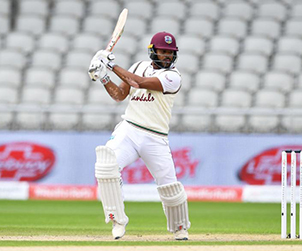Four young batsmen in West Indies’ lower middle order showed fight, application and skill – and perhaps provided a beacon of hope for the future.
Jermaine Blackwood, Roston Chase, Shane Dowrich, Jason Holder. One Jamaican, three Bajans. Two beanpoles, two little guys. All of them 24 years old.
On Wednesday, they made 63, 137*, 74 and 64*, and became only the fifth set of batsmen occupying numbers five, six, seven and eight to make 50-plus scores in the same Test innings. They saved a Test match for West Indies, and in doing so gave them a glimpse, perhaps, of a middle order coming together for the long term.
Going into this Test match, each had a point or two to prove.
Blackwood had come into the series averaging 11.14 in his last seven Test innings, and had made a pair in the first Test. Chase had only made his debut in the first Test. Dowrich had replaced a long-serving wicketkeeper-batsman who had scored half-centuries in his last two Test innings, in awkward circumstances. Holder was the gifted allrounder who hadn’t yet carved out a niche as either batsman or bowler, but had already been burdened with captaincy.
Blackwood seemed lucky to have retained his place here, at his home ground, but showed, in both innings, why he has been regarded as one of the brightest batting talents to emerge from these islands in the last few years.
In both innings, he went after anything remotely full, was unafraid to hit on the up or over the top, and by doing so upset the fast bowlers’ lengths. To do this successfully, a batsman needs an uncommonly good eye, and Blackwood has that. But he remains a rough diamond. It had been apparent even in the overs leading up to his dismissal, when he kept playing a long way in front of his body, both while defending and on-driving, that he was in danger of getting caught bat-pad. He still needs to learn the art of playing spin with soft hands.
Dowrich already knows it. It’s an unusual way to praise a batsman, but his defensive technique against spin was best showcased when he edged the ball. Right through the series, he has used his bat like a cushion while defending, and nearly every time he edged the ball on Wednesday, it died well short of the slips. The slowness of the pitch helped, but his technique was blameless. Only once, when he tried to work Amit Mishra against the turn, did an edge threaten to end his stay. In between there were some stylish shots as well, such as a pull over square leg off Umesh, and an effortless flicked six off Ashwin.
When Dowrich was given out lbw by Ian Gould, who had failed to spot a thick inside-edge onto pad, Holder walked in with a session-and-a-half still left to negotiate. He was the last recognised batsman. He had faced only 24 balls, and West Indies had only just gone into the lead, when India took the second new ball.
Armed with this harder, shinier ball, Shami bowled perhaps the most testing spell from any bowler on the final day, moving the ball both ways off the seam. Holder survived it, not without alarm, and perhaps needed a bit of luck along the way, but there was skill too. He played close to his body, bottom hand loose and ready to leave the handle. His height allowed him to ride the bounce of one particularly nasty lifter and, despite taking a knock on the glove, he kept it down, short of the keeper, with ease.
All the while he kept putting away the scoring opportunities, standing up to his full height to slap a short ball from Ishant to the long-off boundary with a horizontal bat, pulling Shami, and, when Ashwin came back into the attack, driving him against the turn to the left of extra-cover.
That last shot took West Indies’ lead to 50. Time was running out for India.
And all this while, they had seen no way past Chase, the glue that had held all three partnerships together. Tall, imperturbable, and unusually still at the crease for a batsman of his generation, he had repelled everything they had thrown at him. Right from the start of his innings, when he calmly played himself in even as Blackwood went berserk at the other end, he seemed a batsman who knew his own game intimately.
Chase seemed to like the clip through midwicket, and played it at every opportunity, even when he had to take the ball from off stump, even while playing against the turn. The cover drive, however, only came out when the ball was pitched right up. Not for him the on-the-up adventures of Blackwood. Early in his innings, he studiously ignored Ishant outside his off stump, until a half-volley finally arrived; when it did, he got his head right on top of the ball and drove it pleasingly wide of mid-off.
He took his time getting used to the pace and bounce of the pitch, and was watchful against the short ball early on, but began to play the pull more frequently as the day wore on and the pitch slowed down. Against Mishra, he misjudged one sweep, attempting it off a ball that was a touch too full, but played it again next ball, with no thought of what had gone before, and cleared the square-leg boundary. He had chosen the wrong length the previous ball, but what connection did that have to this eminently sweepable ball?
These were glimpses of a batsman playing the game at his own pace, and not letting what was around him intrude into his headspace. He made little adjustments, such as adopting a lower backlift when Shami and Umesh targeted his stumps with a reverse-swinging old ball, but otherwise kept it as simple as possible. Hands close to body while defending, eyes locked on the lifting ball, a clear idea of the whereabouts of off stump.
Trite as it sounds, it was just the basics, done well, over and over, for the best part of 269 balls. The extraordinary thing about Chase’s innings, in only his second Test, was its utter simplicity.






















